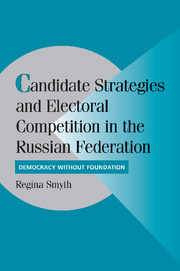 Candidate Strategies and Electoral Competition in the Russian Federation
Candidate Strategies and Electoral Competition in the Russian Federation Book contents
- Frontmatter
- Contents
- 1 ELECTIONS AND THE DEVELOPMENT OF DEMOCRATIC CAPACITY
- 2 ONE STEP FORWARD, TWO STEPS BACK: RUSSIA'S FAILED CONSOLIDATION IN COMPARATIVE CONTEXT
- 3 THE MICROFOUNDATIONS OF DEMOCRATIC RESPONSIVENESS: CANDIDATE STRATEGIES AND ELECTORAL INFRASTRUCTURE
- 4 MANY CANDIDATES, FEW CHOICES
- 5 TO JOIN OR NOT TO JOIN: CANDIDATE AFFILIATION IN TRANSITIONAL RUSSIA
- 6 FINDING FIT: CANDIDATES AND THEIR DISTRICTS
- 7 CAMPAIGNING FOR THE DUMA: MIXED MARKETS, MIXED MESSAGES
- 8 DEMOCRATS, DEMOCRATIC TRANSITIONS, AND RUSSIAN DEMOCRACY
- Appendix A The Sample
- Appendix B The Candidate Survey
- Appendix C Variables Constructed from Survey Data
- Appendix D Sample and Variable Construction for Analysis in Chapter 2
- Works Cited
- Index
- Cambridge Cultural Social Studies
5 - TO JOIN OR NOT TO JOIN: CANDIDATE AFFILIATION IN TRANSITIONAL RUSSIA
Published online by Cambridge University Press: 25 July 2009
- Frontmatter
- Contents
- 1 ELECTIONS AND THE DEVELOPMENT OF DEMOCRATIC CAPACITY
- 2 ONE STEP FORWARD, TWO STEPS BACK: RUSSIA'S FAILED CONSOLIDATION IN COMPARATIVE CONTEXT
- 3 THE MICROFOUNDATIONS OF DEMOCRATIC RESPONSIVENESS: CANDIDATE STRATEGIES AND ELECTORAL INFRASTRUCTURE
- 4 MANY CANDIDATES, FEW CHOICES
- 5 TO JOIN OR NOT TO JOIN: CANDIDATE AFFILIATION IN TRANSITIONAL RUSSIA
- 6 FINDING FIT: CANDIDATES AND THEIR DISTRICTS
- 7 CAMPAIGNING FOR THE DUMA: MIXED MARKETS, MIXED MESSAGES
- 8 DEMOCRATS, DEMOCRATIC TRANSITIONS, AND RUSSIAN DEMOCRACY
- Appendix A The Sample
- Appendix B The Candidate Survey
- Appendix C Variables Constructed from Survey Data
- Appendix D Sample and Variable Construction for Analysis in Chapter 2
- Works Cited
- Index
- Cambridge Cultural Social Studies
Summary
… As rational individuals, office seekers will put forth only as much effort [in creating party organizations] as they believe is essential to realizing their own ambitions. They will only join in creating, shaping and maintaining political organizations best suited to their purpose.
Schlesinger (1994: 33)The growing influence of President Putin's United Russia (UR) party organization marks a critical junction in post-Soviet political development. Between 1999 and 2004, UR emerged suddenly and with no structure and established itself as a dominant party organization. Increasingly, the party, orchestrated by Kremlin-based puppeteers, relies on coercion and out-of-system behavior to ensure electoral success and legislative discipline, thereby increasing the power of the executive and diminishing or eliminating political opposition. The meteoric rise of UR was impossible without the more general instability and disarray within the party system that was rooted in the very weak ties between party elites and voters, and elites and the organization, as well as the large numbers of independent candidates and incumbents who participated in elections.
Consistent with the general argument, this chapter explains the weakness of Russian political parties and the rise of UR in terms of individual candidates' strategies. The Russian electoral system presents candidates for the national legislature with an interesting and substantively important choice: Run for office under a party banner, or campaign as an independent. Candidates who choose to affiliate are faced with the additional decision of which party to join.
- Type
- Chapter
- Information
- Candidate Strategies and Electoral Competition in the Russian FederationDemocracy without Foundation, pp. 102 - 130Publisher: Cambridge University PressPrint publication year: 2006


